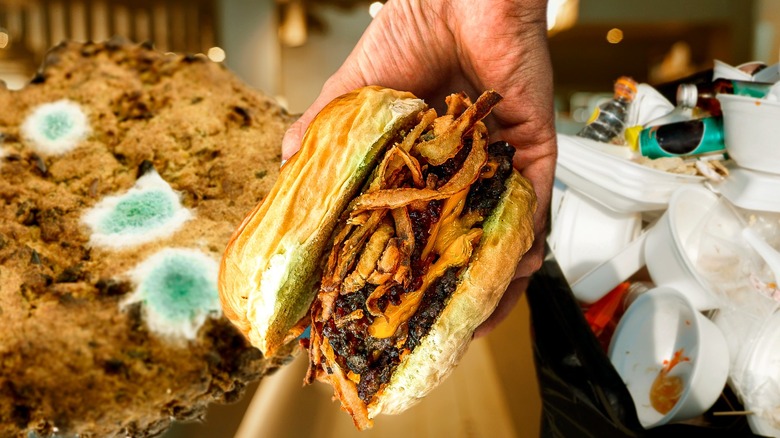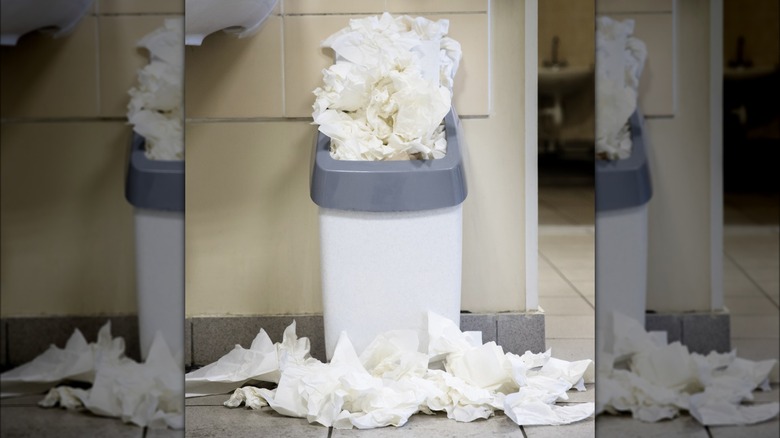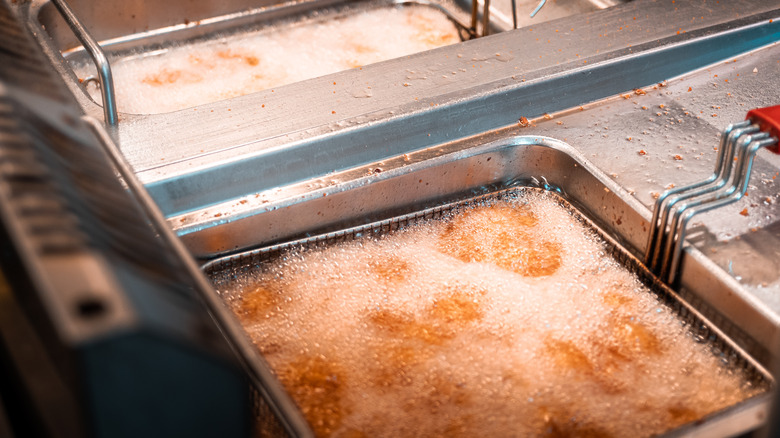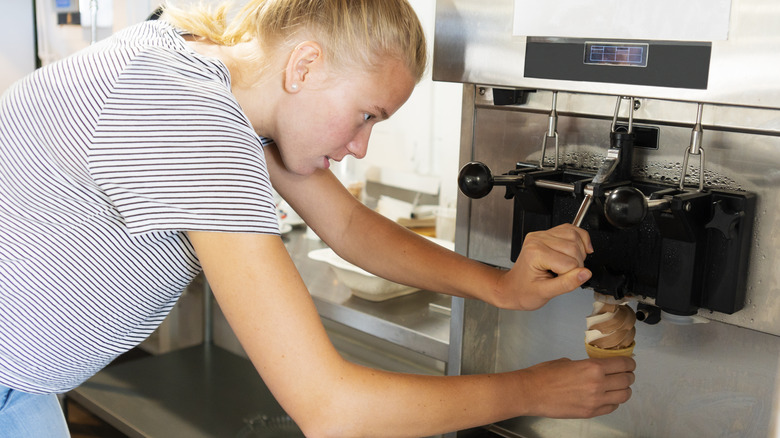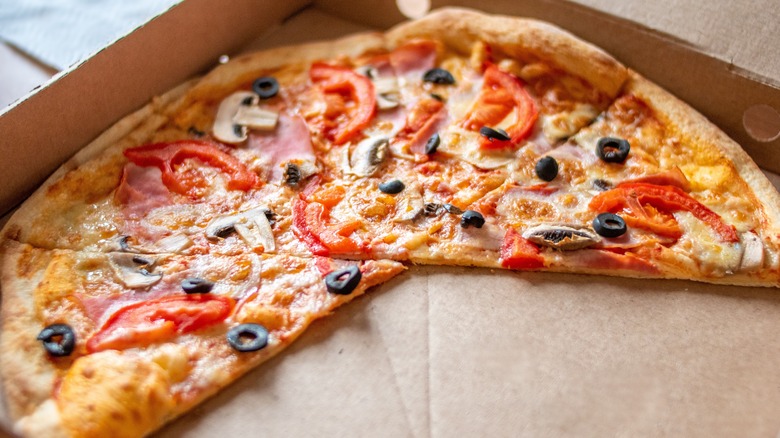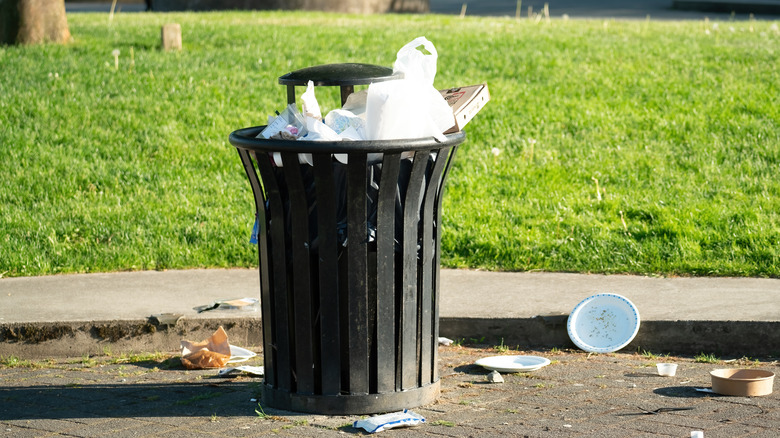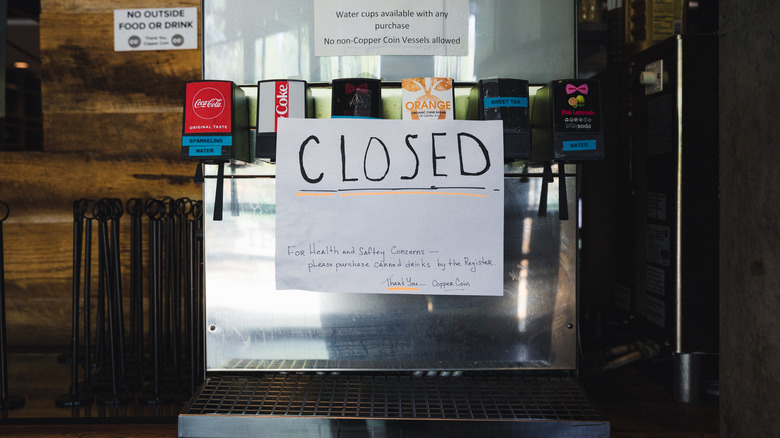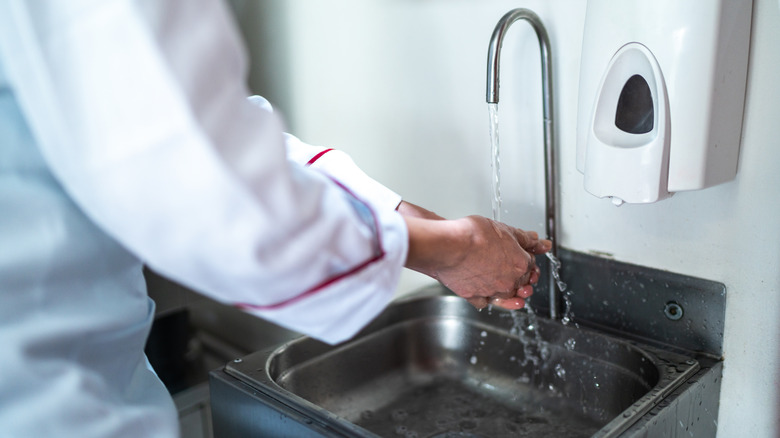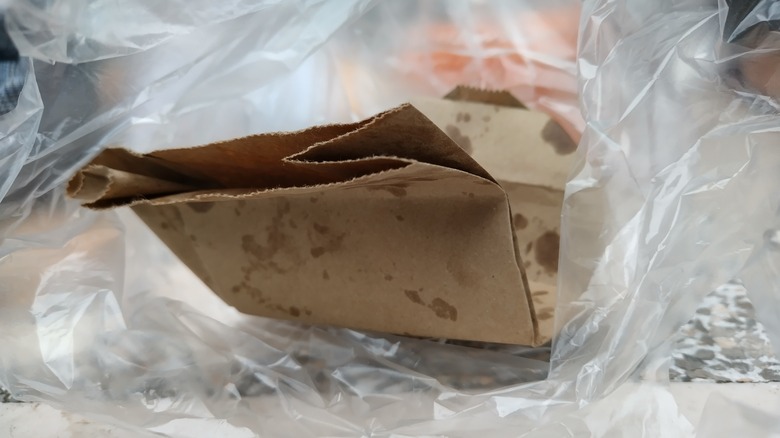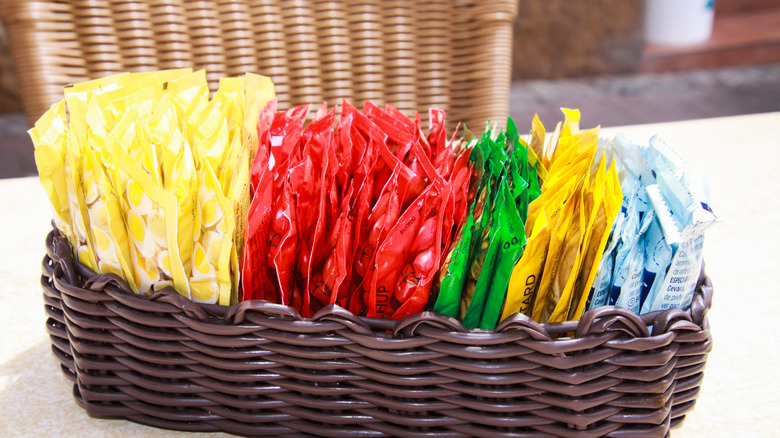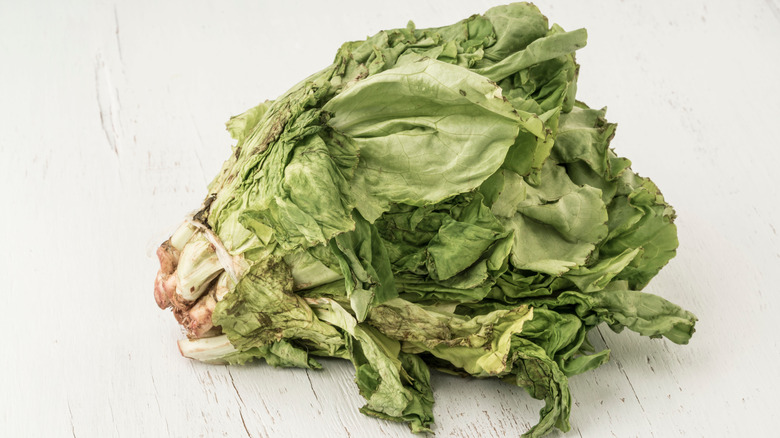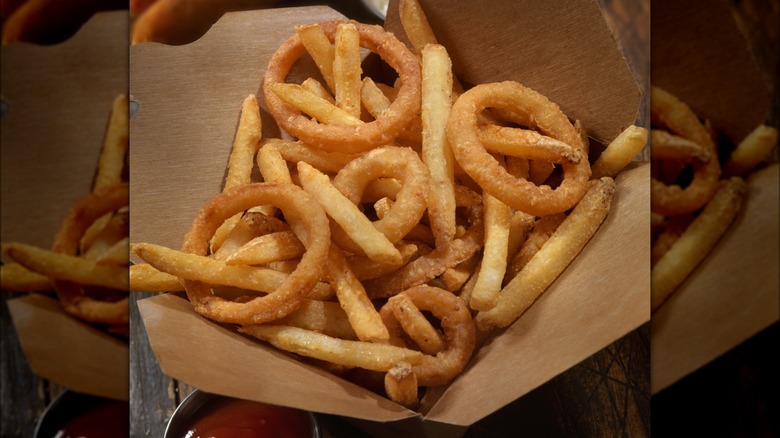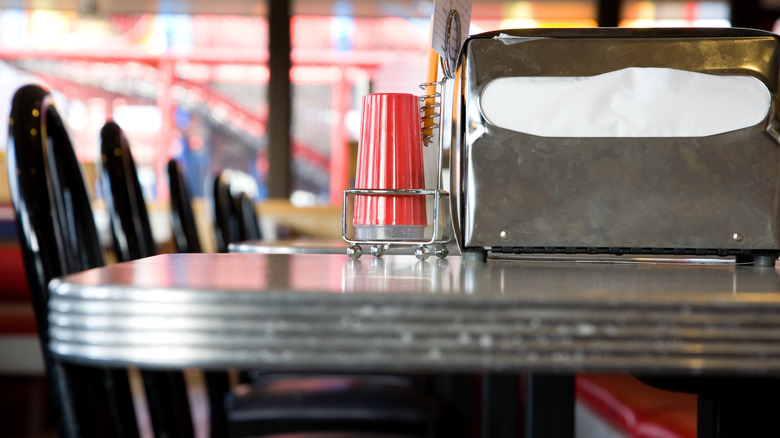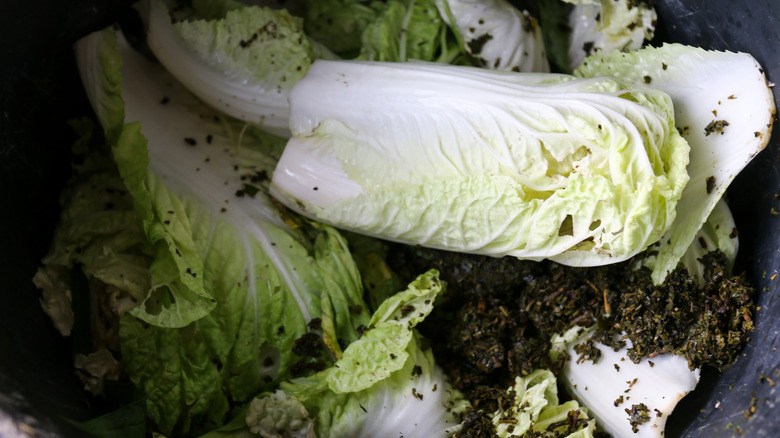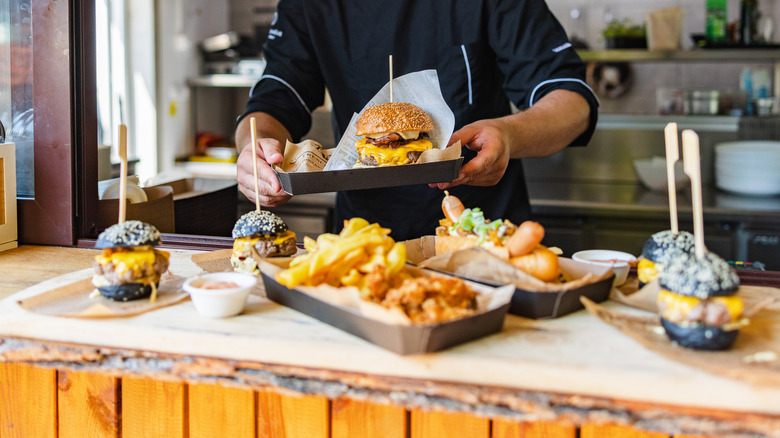16 Signs You Should Throw Out Your Fast Food Before Eating It
Reliability and consistency are two of the main reasons fast food became so popular in the first place, but not all fast food meals are created equal. As someone who has worked as both a manager and a cook in a multitude of different fast food restaurants and kitchens, I know how wildly the quality of food can vary. If you've ever found yourself regretting eating a fast food meal instead of just throwing it out, you aren't alone.
Thankfully, there are many ways to figure out if you might be about to ingest something dangerous ahead of time, rather than accidentally subjecting your body to an unpleasant and potentially harmful experience. From the atmosphere of a restaurant's lobby to the color or texture of the food on your plate, telltale signs that you should throw out your fast food before eating it do exist. You just have to keep an eye out for them.
1. The bathrooms are dirty
A fast food restaurant's bathroom can tell you a lot about the quality of its staff. If you walk into a restroom and feel like you won't be able to properly wash your hands because of a lack of toiletries, or if the floors are in desperate need of cleaning, there's a high probability other parts of the restaurant won't be much better.
As expressed in an interview with GQ, chef David Chang judges restaurant bathrooms by a rather specific metric — whether or not employees have been cleaning the back of the toilet. While this may be a good way to see how dedicated the staff at a high-end restaurant is, when looking at a fast food bathroom, it's not always necessary to get that granular. That being said, if the floors are gross and you can't leave feeling clean or refreshed, it probably means you shouldn't eat the food there.
2. Your fried food is chewy or soggy
Everyone knows the difference between a fresh chicken finger and a chicken finger that has been slowly drying out under a heat lamp for the past 20 minutes. A tougher chew from dried-out meat is one thing, but if your fried food is especially slimy or damp, don't eat it. This is a signal that the food has been cooked incorrectly.
Improperly breading the meat or not heating the oil properly are mistakes everyone makes when frying food at home, but most fast food restaurants should be equipped with industrial fryers. These machines heat and hold the oil at the appropriate temperature and usually come with built-in timers that have been specifically designed for the restaurant's menu items. If your fried food is greasy and gross even with these precautions in place, either it hasn't been cooked long enough or the oil needs to be changed out.
3. The ice cream has streaks
Fast food ice cream machines have a reputation for being pretty temperamental. One of the reasons, "Sorry, the ice cream machine is down," has become such a commonly used phrase is because of how frustrating it can be to keep them clean. Even though restaurants like McDonald's often have dedicated cleaning schedules posted in the back, it will always be up to the employees and their managers to make sure this is properly enforced.
If your fast food ice cream treat has streaks of discoloration or smells a bit like spoiled milk, it would be best to throw it away before eating it. This is evidence that the ice cream machine is not being serviced properly. Eating spoiled cream has the potential to cause abdominal cramping, vomiting, and diarrhea, so it's not worth taking the chance if you notice these signs.
4. It's been over seven days since you bought it
There's nothing wrong with putting some leftovers in the fridge and then eating or repurposing them the next day (for example, some fast food biscuits make great breakfast sandwiches), but it's important to remember that you are working under a limited time window. While it's a common joke to say that a fast food burger feels like it can last forever, the reality is prepared food only stays safe to eat for so long before it needs to be thrown away.
It's obvious to everyone that refrigerated food beginning to grow mold and smell should be tossed. However, even if there are no clear signs you should throw out your food, if it's been over a full week since the meal was cooked, it needs to go. All open or prepared foods should be disposed of after seven days, according to the FDA Food Code, and some (like burger patties and chicken nuggets) really shouldn't be kept longer than four.
5. The trash cans are overflowing
One surefire way to determine how sanitary a fast food restaurant may be is to pay attention to how it handles food waste. A good kitchen and front-of-house crew will make sure that the common areas that customers have access to are as clean as possible. If the first thing you see when you arrive is a bunch of overflowing trash cans in the parking lot, chances are the inside of that fast food joint won't be much better.
To be clear, this does not include those large industrial dumpsters most businesses have out behind the store. The restaurant has far less control over when those are emptied, and if you show up right after a supply truck delivery, chances are the dumpster will be packed solid with empty boxes. However, trash cans inside the building that are covered in food residue are a clear indication the employees probably don't care about how clean the rest of the restaurant is.
6. There's no hot water in the bathroom
Finding out there's no hot water in the bathroom after you place your order is one definite sign you should throw out your fast food before eating it. Hot water is critical to ensuring that you (and the employees currently handling your food) can wash your hands properly. If you can't get any hot water in the bathroom, the sinks in the kitchen and handwashing stations probably don't have any hot water either.
The availability of hot water in a fast food restaurant isn't just important for washing hands. Kitchen utensils and equipment, along with customer-facing products like plastic food trays, need to be continually washed throughout the day. Whether the franchise is using a commercial dishwasher (which needs to be able to reach at least 165 degrees Fahrenheit to properly sanitize items) or employees are washing the equipment manually, keeping hot water available all day long is a must.
7. You see specks in your drink
No matter how much effort a restaurant puts into making sure its cups stay clean, it's all for nothing if the soda fountain hasn't been appropriately maintained. Having the leftover drips of the last person's drink of choice fall into your cup is bad enough, but if a soda fountain's nozzles aren't cleaned regularly, mold will quickly grow inside them. If you've ever suddenly spotted little floating specks in your half-finished fountain drink, you just accidentally consumed mold.
Thankfully, it's usually fairly easy to check your drink ahead of time just by looking at it. If you are in a fast food place that doesn't use see-through plastic cups, the best thing to do would be to flush the fountain nozzle with water first. With one of the newer, all-in-one electronic soda fountains, this can be done just by pressing the big "Water" button. If you're trying to flush out one of the older models, press down on the little tab next to the nozzle itself.
8. Employees handle food and money without washing hands
Gloves are less common in the food industry than you would think, which is why making sure employees wash their hands between tasks is so important. Even when gloves are worn, those same gloves should never be used for both food preparation and for handling money. In a normal fast food restaurant with good managers and trained staff, this isn't usually a problem. But unfortunately, a sudden rush of orders can cause any kitchen to lax on the rules.
Properly washing your hands to a food service standard takes time. However, no matter what the regulations are, if a large amount of orders come in at once, the kitchen is going to do everything it can to get through them as quickly as possible. It's okay to cut corners in certain situations, but if you see someone wrapping up your fast food with the same unwashed hands they just touched money with, it's best not to eat it.
9. There is food residue on the wrapper or container
Few things are less appealing than pulling away from a drive-thru, reaching into your bag, and being rewarded with a smear of mystery sauce instead of a dry wrapper. If your fast food order has any sort of remains on the container the food is in, that means there is a possibility of cross-contamination. For people with any sort of food allergies, this is an especially important thing to be mindful of.
Most fast food franchises employ an assembly line system, which keeps the person packing the food separate from the people in the kitchen who are making it. This should theoretically keep two different orders from ever getting mixed up, but it doesn't always work that way. If your meal made it to you with some sort of unexplained mess on the outside of the wrapper, you shouldn't trust what's inside — and it's a sign you should throw it out before eating it.
10. The sauce packets are expired
One way to gauge how much a fast food restaurant cares about the quality of its food is by paying attention to how often it rotates out the sauce packets. Making sure customers have access to up-to-date condiments is one of the easiest things a restaurant can do. If the sauce packets are expired, there's a good chance the food in the kitchen isn't entirely up to standard.
It can be difficult to determine the expiration of fast food condiment packages. Most of them only give that information on the box they are delivered in, which the customer will never see. If there isn't a printed date to check, look at how the packages themselves are holding up. Sauce packets that are extremely puffy for no reason are likely expired, and if you are ever in doubt, you can always open one to test it — just make sure to squirt it onto something other than your food first.
11. The lettuce is brown and mushy
Every franchise has a different method for handling lettuce, but the most common way it is prepped for service is by chopping it up, placing it in a plastic bin, and setting it in a cooler on the assembly line (like it is at every Subway). Because of the heat of the kitchen and the potential for other food items to fall into the lettuce, this container should be changed out periodically just like everything else on the line. Unfortunately, this doesn't always happen.
It's perfectly fine to eat lettuce that's turning brown, but not if it is also mushy. Mushy, rotten lettuce is a perfect breeding ground for bacteria like E. coli, salmonella, and listeria, and it should never be served to customers. Finding slimy lettuce in a salad, burger, or taco is a clear indication you should avoid consuming it.
12. The restaurant smells bad
Each fast food restaurant is typically known to have its own distinct smell, whether it's the overwhelming scent of baking dough at Domino's or the salty fragrance of french fries at McDonald's. It would take a pretty large mess (or a long accumulation of small messes) to overpower the smell of food cooking in a small building. But if you order your meal online, and then walk into a store that smells distinctly off, you should skip your fast food meal and just toss it.
Restaurants should only smell either like cleaning supplies or like the food it's serving. A fast food location with a weird odor might be having issues with its sewer system, or perhaps the staff members just aren't performing their cleaning duties properly. Either way, if just walking into the restaurant gives you the urge to gag, the food there doesn't need to be eaten.
13. You (or an employee) were exceptionally rude
Working in fast food is stressful, and frustration with co-workers, managers, and customers can bubble up at inappropriate times. Everyone has had a conversation suddenly turn heated for one reason or another. If you just got into an argument with the person tasked with making your food, however, it might be a good idea to reconsider whether or not you want to eat it.
Even though states like California have raised the minimum wage of fast food workers to $20, most franchise employees across the country are still underpaid. Fast food workers are also usually teenagers or young adults who are at school for part of the day. People make rash, split-second decisions when they are angry, and when young kitchen workers are already under a lot of stress, you don't want to give them any reason to consider spitting in your food.
14. Your food contains items you didn't order
Cross-contamination can come in many different forms, and that includes any food items you didn't specifically order for yourself. If you get home and realize you were accidentally given someone else's fast food, throw it out before eating it. Even if it looks like food you would probably enjoy, you have no idea what kind of modifications they might have made to the order.
The umbrella of "fast food you didn't order" also covers things like surprise onion rings or mozzarella sticks appearing in your french fries. It might seem like a harmless bonus, but fries and onion rings should be cooked in separate fryers to avoid having gluten spreading from the breading to the fries. For those who have any sort of gluten intolerance or food allergies, this is especially important to keep in mind.
15. The floors or tables are sticky
There's a lot you can learn about how clean a fast food place is just by stepping foot inside the restaurant. If that second step comes with a very noticeable tacky click, however, you may be better off turning around and walking right back out. Fast food restaurant floors should be cleaned multiple times throughout the day, and if employees aren't following through with this, there's a high probability the kitchen isn't very clean either.
Sticky tables are even worse, as making sure customers have a clean and sanitary place to eat their meals is one of a fast food restaurant's most important jobs. Tables that have residue from past customer spills, or layers of grease that haven't been wiped away in days, are absolutely signals that you shouldn't eat there. If you repeatedly get bad drive-thru meals from one spot in particular, on your next visit, try walking inside and having a look around.
16. There's dirt in the salad
A fast food restaurant may buy its lettuce pre-chopped and wrapped in plastic bags, but it is still common (and cheaper) for franchises to order whole heads of lettuce instead. Whole heads of lettuce need to be cleaned and cut by the employees, which means it is up to them to ensure all the dirt and pesticides are washed off properly.
When shipped to restaurants, whole lettuce heads typically come straight from whatever farm the franchise has a deal with. They arrive in large cardboard boxes, with each box usually containing 24 heads of lettuce wrapped in a large plastic bag. The lettuce needs to be carefully washed to eliminate all traces of lingering objects, whether that's residual dirt or biological material. Only then should it be cut for prep and service. Finding dirt in your fast food salad means a shortcut has been taken somewhere, and it's a sign you should throw it out.
Methodology
Making sure you are avoiding food waste as best you can is always important, but sometimes, you'll find yourself in a situation in which the healthiest choice is just to throw your food out. All of the instances above are included because, if you know about these signs beforehand, you will be better prepared to catch them and hopefully not find yourself in this situation at all. I have personally seen every one of these warning signs at fast food restaurants before (as both an employee and as a customer) and have suffered the gastrointestinal consequences of ignoring many of them more than once. By recounting them here, I hope that you will be on the lookout for them yourself from now on and, as a consequence, have more pleasant fast food experiences in the future.
